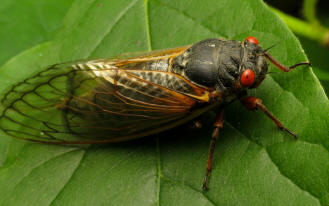 Get ready, Brood X (Ten) of periodical cicadas is coming! Often mistakenly called "locusts," these insects really are cicadas. Locusts actually are grasshoppers. Periodical cicadas, unlike annual cicadas, emerge every 13 or 17 years, depending upon the species. In our area, Brood X is coming out around mid-May after being underground since 2004! Periodical cicadas are given Brood numbers to designate the region and year of emergence. Brood X will emerge in Pennsylvania, Tennessee, Virginia, West Virginia, Delaware, Georgia, Illinois, Indiana, Kentucky, Maryland, Michigan, North Carolina, New Jersey, New York and Ohio.
Get ready, Brood X (Ten) of periodical cicadas is coming! Often mistakenly called "locusts," these insects really are cicadas. Locusts actually are grasshoppers. Periodical cicadas, unlike annual cicadas, emerge every 13 or 17 years, depending upon the species. In our area, Brood X is coming out around mid-May after being underground since 2004! Periodical cicadas are given Brood numbers to designate the region and year of emergence. Brood X will emerge in Pennsylvania, Tennessee, Virginia, West Virginia, Delaware, Georgia, Illinois, Indiana, Kentucky, Maryland, Michigan, North Carolina, New Jersey, New York and Ohio.
A recent article in the Wall Street Journal caught my attention because it warned vacationers to be alert for regional areas of the country where periodical cicadas are to emerge this year. Given their sheer numbers and resulting noise, cicadas could be serious unwanted guests at outdoor venues such as weddings and other events. The article further cited examples of actual event rebooking taking place for this spring. The loud noise and overwhelming number of these insects, literally crawling everywhere, were cited as serious outdoor activity deterrents. Their noise comes from male cicadas and is produced by their rubbing wings over a pair of mid-thoracic ridges that are below each side of the rear abdominal area. Their often "in-unison" chorus can be quite loud.
Periodical cicadas, genus Magicicada, differ from annual cicadas in their life cycle. Annual cicadas emerge every year and have lifecycles as underground nymphs that can vary from one to five or more years. Some species may live longer and their brood life cycles overlap, meaning that every summer, some will emerge. However their emergence above ground as adults is not synchronized like the periodical cicadas.
Periodical cicadas have a number of distinct "broods" that go through either a 17-year, or in some parts of the country, a 13-year lifecycle. These cicadas tend to be darker than their greenish relatives, sometimes black with orange or reddish markings. Their longer lifecycle may have developed as a response to predators such as the cicada killer wasp or praying mantis. Their underground form technically is a nymph, not a larvae like butterflies.
For both cicada types, once the nymphs have emerged and "transitioned" to a winged cicada, their empty brown exoskeletons are found clinging to tree trunks above the soil area from which they emerged. Emergence begins typically in early to mid-May when the soil eight inches below ground reaches around 64 degrees F. Back in 2004, people began reporting them around mid-May. If weather is warmer, emergence might start in late April and usually ends by late June.
Cicadas tend to emerge once trees have grown leaves. Deciduous trees such as ash, maple, oak and even red bud are the preferred host trees of periodical cicadas. Young trees especially are at risk. Damage comes from female cicadas piercing the tender outer branches with their ovipositor and inserting eggs. These eggs hatch and feed on sap causing the rest of the branch to brown out to the tip and die. At some point, the nymphs drop to the ground burrowing to remain for the next 17 years.
I remember when this Brood X emerged in 2004. At that time I had a young white birch tree that I had driven home from the Berkshires in Massachusetts. Wanting to protect it, I purchased several yards of cheap nylon netting fabric and fashioned a tent to keep female cicadas from laying eggs on its branches. My tent worked fairly well with only a couple of cicadas making their way inside. However a line of red bud trees in my yard did not fair so well. A multitude of branch tips died resulting in very unsightly brown dead branches. Upon close examination one could see where the female cicada had slit the branch to insert her eggs.
Cicadas feed only on sap and do not bite or sting. They are not major agricultural pests, but in some outbreak years, the sheer numbers of females laying their eggs in the tender outer branch tips may overwhelm trees and smaller trees may suffer real damage. Some species have turned to crops such as sugarcane and in a few cases have injured cash crops such as date palms, grapes, and citrus trees. Cicadas some-times also cause damage to ornamental shrubs.
While there are no predators that prey on the periodical cicadas, there are plenty of animals that feast on them because they are so abundant and easy to catch. This includes birds, rodents, snakes, lizards, and fish. Mammals like opossums, raccoons, and even cats and dogs will eat them. Cicadas were eaten by humans in ancient Greece and are eaten today in many countries in Asia as well as North America, and central Africa. Female cicadas are prized for being meatier. The brown molted exoskeleton shells of cicadas are even used in traditional Chinese medicine.
Cicadas have been featured in literature since the time of Homer's Iliad, and used as designs in decorative art from the Chinese Shang dynasty (1766–1122 BC). They are described by Aristotle in his History of Animals and by Pliny the Elder in his Natural History. Obviously cicadas have been around for a long time. Our area should prepare for their emergence in early May. They are coming!
Read other articles about controlling insects & garden pests
Read other articles by Connie Holland